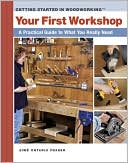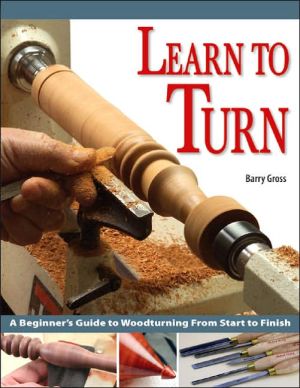A Splintered History of Wood: Belt-Sander Races, Blind Woodworkers, and Baseball Bats
In a world without wood, we might not be here at all. We wouldn't have had the fire, heat, and shelter that allowed us to expand into the planet's colder regions. If civilization somehow did develop, our daily lives would be vastly different: there would be no violins, baseball bats, chopsticks, or wine corks. The book you are now holding wouldn't exist.\ Spike Carlsen's A Splintered History of Wood is a grand celebration of all things wooden and the characters who lovingly shape...
Search in google:
In a world without wood, we might not be here at all. We wouldn't have had the fire, heat, and shelter that allowed us to expand into the planet's colder regions. If civilization somehow did develop, our daily lives would be vastly different: there would be no violins, baseball bats, chopsticks, or wine corks. The book you are now holding wouldn't exist. Spike Carlsen's A Splintered History of Wood is a grand celebration of all things wooden and the characters who lovingly shape them—eccentric artisans and passionate enthusiasts who have created some of the world's most beloved musical instruments, feared weapons, dazzling architecture, and bizarre forms of transportation. From champion chainsaw carvers to blind woodworkers, from the Miraculous Staircase to the Lindbergh kidnapping case, here is a passionate, personal, amazingly entertaining exploration of nature's greatest gift. Publishers Weekly Carlsen (Readera's Digest Complete Do-It-Yourself Manual) gives a solid history of wood as he travels the world, analyzing the vast number of uses of a mundane natural resource. In doing so, Carlsen also uncovers the wide variety of personalities that work with wood every day, from the chainsaw artist appropriately named the "Wild Mountain Man" to the blind cabinetmaker who "can see things with [his] fingers that you may not see with your eyes." He uncovers places where wood golf clubs are still manufactured today; explains which type of wood is best for a baseball bat; takes readers through the painstaking process used to make the beautiful Stradivarius violins and Steinway grand pianos; he also demonstrates how the gondola is a "floating work of efficiency and ergonomic art." At one point, Carlsen visits a company in Maine that produces 50 billion toothpicks and 12 billion wooden matches each year. Carlsen includes photographs throughout this engaging and exhaustively researched work. (Sept.)Copyright © Reed Business Information, a division of Reed Elsevier Inc. All rights reserved.
A Splintered History of Wood\ Belt Sander Races, Blind Woodworkers, and Baseball Bats \ \ \ By Spike Carlsen \ HarperCollins Publishers, Inc. \ Copyright © 2008 \ Spike Carlsen\ All right reserved.\ \ ISBN: 9780061373565 \ \ \ \ Chapter One\ Extraordinary Woods\ As I drive toward Ashland, Wisconsin, home of the company that lays claim to selling the oldest workable wood on the planet, the convoys of fully loaded pulpwood trucks I pass remind me of the rich, ongoing logging tradition of the area. I'm in Sawdustland. It's a fitting place for a company named Ancientwood to call home. I find the pole building that serves as the warehouse/store/Internet headquarters, and I find owner Bob Teisberg. He greets me by making three introductions. The first is to his shop helper, Dante; the second is to a mammoth slab of kauri wood standing by the door; the third is to his sense of humor. "Yep, we call that slab Dante's Inferno. He went through hell for two straight weeks sanding and finishing that baby. But just look at it."And when you look closely at this gigantic slab, you set your eyes on things of an unworldly nature. For starters, it's 5 feet wide, 7 feet tall, and 3 inches thick. It's sanded smooth as glass, with a finish and grain that not only glow but dance like a hologram, depending on your viewing angle. The color, figure, and texture are unlike any wood I've ever seen. And the reason is, it is a wood I've never seen. It's a wood most people have never seen. The slab is from afifty-thousand-year-old kauri tree, mined from the bogs of New Zealand.\ Fifty-Thousand-Year-Old Wood Lives And Breathes Again\ The route a slab of wood needs to travel to get from 48,000 BC on the North Island of New Zealand to AD 2006 in Ashland, Wisconsin, is not an easy, inexpensive, or clean one. "Originally we thought some cataclysmic event—a tsunami, an earthquake, an asteroid—was responsible for the death of the trees,"explains Teisberg, the North American distributor for Ancient Kauri Kingdom wood. "But when they sent samples to the University of New Zealand for study, they found the trees died at different times and fell in different directions, so our best guess is they died of natural causes."But it doesn't matter so much how they died as where and when they died. When most trees die, they keel over and decompose within a few decades. But these kauri trees keeled over into bogs—an oxygen-starved, fungus-free environment—that created a time-warp cocoon that preserved the timber in pristine condition, until a Kiwi by the name of David Stewart happened along.\ The Ancient Kauri Kingdom's informational DVD, in which Stewart stars, shows the process used to extract the trees. Most of the trees are found in farm pastures, where they reveal their presence by a small exposed section. "If you're a farmer you really don't want these things in your field,"explains Teisberg. "Nothing grows on them, and animals can break a leg if they fall through a rot pocket, so they're just a nuisance."When they go into an area, they're never quite sure what condition or size the trees will be in; there's really nothing scientific about it. They get in there with a backhoe, give the exposed part a wiggle, and if the land 100 feet around them moves they know they've got a monster. And they've found some monsters.\ The extraction process involves moving man and machine across the boggy land, trenching all around the log, then using a chainsaw with a bar the length and lethalness of an alligator to cut the log in two if it's too large to get out in one piece. The video of the process, which absolutely oozes testosterone, shows a cigarette-chomping Stewart, covered in slime, standing in the bucket of the backhoe, sawing a 60,000-pound monster in two with a chainsaw sporting a 6-foot-long bar. There are hydraulics, chains, cables, muck, and heavy machinery everywhere. The wood chips flying out of the kerf look as clean and uniform as if he were slicing through a 25-year-old birch tree. At one point he pauses to show the camera a handful of forty-five-thousand-year-old kauri leaves. Once the sections are cut to manageable size, they're winched, pushed and pulled up out of the trench, rolled onto massive flatbed trucks, and then hauled to the company's yard, where they're marked and cut into slabs. The logs have reached the 100 percent saturation point after lying in the bogs for eons, and the drying process is a long drawn-out affair as the wood finds a new moisture balance.\ The crown prince of kauri logs is the 140-ton "Staircase"log discovered in October of 1994; the largest known log of any kind ever to have been extracted anywhere. The crew broke two 90-ton-capacity winch cables attempting to haul the trunk out in a single piece. They cut the tree into separate 110- and 30-ton sections, hauled the sections out, and then let them sit untouched, not wanting to cut the trunk into slabs because of its Olympic-caliber size. Four years later, Stewart built a 20-inch-thick reinforced concrete pad, placed a 50-ton, 12-foot-diameter, 17-foot-tall section of log on top of it, and went after it with a chainsaw. After three hundred hours of carving and two hundred hours of finish work, the world's largest, and surely oldest, single-piece circular stairway was complete. It's built inside the log. If you pause to count the growth rings as you're ascending you'll find 1,087 of them.\ The scene in Ashland, Wisconsin, is considerably tamer. Teisberg walks me past pile after pile and specimen after specimen of imported ancient kauri. He has everything ranging from 6-foot-thick stumps to 1/16-inch-thick veneers. At one point, Teisberg stocked what he claimed to be the "largest single piece of wood available in the United States"—and I never found any challengers. The slab measured over 20 feet long, 5 1/2 feet wide, and 4 1/2 inches thick; it was estimated to have grown for a thousand years, and, amazingly, it contained not a single knot.\ \ \ Continues... \ \ \ \ Excerpted from A Splintered History of Wood by Spike Carlsen\ Copyright © 2008 by Spike Carlsen. Excerpted by permission.\ All rights reserved. No part of this excerpt may be reproduced or reprinted without permission in writing from the publisher.\ Excerpts are provided by Dial-A-Book Inc. solely for the personal use of visitors to this web site.\ \
Introduction xiiiExtraordinary Woods 1Fifty-Thousand-Year-Old WoodLives and Breathes AgainIn Quest of the World's Most Expensive Board FootOak: The Breakfast of CivilizationsThe Wood Freak ShowBamboo: The Grass That Thinks It's a WoodRescuing Redwood the Hard WayLogging the Industrial ForestWood: How It Got Here, How Trees Make ItThe Wacky World of Woodworkers 46A Chainsaw Artist a Cut Above the RestMy Seven Awkward Minutes with theMan Who Carves FerrarisWoodworking Blind-Just Like Everyone ElseHow Much Wood Would a Wood Collector Collect?Nakashima: The Pavarotti of Woodworking Still SingsMy Almost-Perfect Interview withWoodworker Jimmy CarterThe Tools That Work the Wood 91As the Lathe Turns: Making Golf Tees with the MasterTool Junky HeavenThe Table Saw That Couldn't Cut a Hot Dog in HalfBelt Sander Racing: A Saga of TrueGrit, Speed, and Victory (sort of)Wood in the World of Music 116Stradivarius Violins: The SweetestSound You've Never HeardThe Making of Sweet Baby James's GuitarDrums: And the Beat Goes On and On and On ...The Steinway D: Twelve ThousandPieces of Indestructible MusicThe National Music Museum: Six Hundred ZithersB. B. King, and One-Ton DrumsWood in the World of Sports 153Baseball Bats: A David-and-Goliath AffairGolf: Persimmon Scores a Hole in OneTossing Telephone Poles and Other Curious SportsThe Art of the Pool CueTennis: The Racket aboutWood RacquetsLumber Jacks and Lumber JillsWood as Shelter 185Living in Trees: From Papua, NewGuinea, to Washington StateThe History of Housing from Log Cabin to, Well, Log CabinEverything You Never Wanted to KnowAbout Construction LumberA Dirty Rotting ShameWinchester House: The Thirty-Six-YearRemodeling ProjectWood in Day-to-Day Life 208When Wood Was Everything and Everything Was WoodThe Lindbergh Kidnapping, the TedBundy Tree, and Forensic WoodPens and Pencils: Getting to the PointA Barrelful of Coopers, Kegs, and TraditionTrue Relics of the CrossFifty Billion Toothpicks Can't Be WrongWood, Weapons, and War 252Ten Great Moments in Catapult HistoryA Tale of Two Warships: One Unsinkable, One UnsailableThe Twang of the BowWhite Pines and WarPine Roots versus Atomic BombsWood by Land, Air, and Sea 287The Spruce Goose Made of BirchGo Fly a Person: Kites for Work and PlayTrains: Riding the Wooden RailsIn Search of the Lost ArkThe Song of the GondolierWood in Unusual Uses and Peculiar Places 313Venice: The City Perched on WoodWood Pipe Takes a BowBuilding a Staircase to HeavenAcademy Award Nominees for OutstandingPerformance by a Wooden StructureRoller Coasters: Mobius Strips of Screaming WoodEpilogue: Trees-Answers, Gifts, and Ducks in the Wind 349Notes 359Resources 373Bibliography 383Photography and Illustration Credits 391Index 393About the Author 413
\ NPR Morning Edition“Wonderfully strange and interesting....Mixing well-researched history, trivia and humorous anecdotes, A Splintered History of Wood meanders from chainsaw artists to belt-sander races, from Steinway pianos airdropped during WWII to the first know wooden tool: the toothpick.”\ \ \ \ \ Family Handyman magazine“Engaging, informative...Spike’s wide-eyed enthusiasm is catching, and his curiosity takes him way beyond the ordinary...[Splintered History] is for anyone interested in how this humble material, and the people who work with it, have made us who we are.”\ \ \ Booklist"Who knew wood could be this fascinating?"\ \ \ \ \ Family Handyman Magazine"Engaging, informative...Spike’s wide-eyed enthusiasm is catching, and his curiosity takes him way beyond the ordinary...[Splintered History] is for anyone interested in how this humble material, and the people who work with it, have made us who we are."\ \ \ \ \ Morning Edition"Wonderfully strange and interesting....Mixing well-researched history, trivia and humorous anecdotes, A Splintered History of Wood meanders from chainsaw artists to belt-sander races, from Steinway pianos airdropped during WWII to the first know wooden tool: the toothpick."\ \ \ \ \ Publishers WeeklyCarlsen (Readera's Digest Complete Do-It-Yourself Manual) gives a solid history of wood as he travels the world, analyzing the vast number of uses of a mundane natural resource. In doing so, Carlsen also uncovers the wide variety of personalities that work with wood every day, from the chainsaw artist appropriately named the "Wild Mountain Man" to the blind cabinetmaker who "can see things with [his] fingers that you may not see with your eyes." He uncovers places where wood golf clubs are still manufactured today; explains which type of wood is best for a baseball bat; takes readers through the painstaking process used to make the beautiful Stradivarius violins and Steinway grand pianos; he also demonstrates how the gondola is a "floating work of efficiency and ergonomic art." At one point, Carlsen visits a company in Maine that produces 50 billion toothpicks and 12 billion wooden matches each year. Carlsen includes photographs throughout this engaging and exhaustively researched work. (Sept.)\ Copyright © Reed Business Information, a division of Reed Elsevier Inc. All rights reserved.\ \ \ \ \ School Library JournalAdult/High School\ Carlsen explores our reliance on wood from numerous angles. A carpenter, woodworker, and author of dozens of books and articles on home improvement, he knows his subject well, and his love and respect for trees and all things made from them are evident on each page. The author includes just enough of the science of trees and wood, and of the technology of wood products and woodworking, to inform but not burden lay readers. Numerous stories add immeasurably to the book's appeal. Readers are told how a Steinway piano is built, why a Stradivarius violin is so special, about the role of the long bow in military history, and how pens and pencils evolved. In addition, there are discussions of the offbeat, including a full-scale (and functional) Ferrari carved of wood, the 36-year remodeling project known as the Winchester House, a staircase with no visible means of support, and the use of wood forensics in the Lindbergh kidnapping case. Carlsen explores the extraordinary variety of woods on our planet, the profession and hobby of fine woodworking, the tools used to work wood, and the many uses of it in our lives-in music, sports, shelter, furniture, weapons, and transportation. The volume ends with a word on the highly complex issues surrounding human use of the world's forests and the consequent effects on the global environment. Black-and-white photos are included. Thoroughly researched, thoughtful, and entertaining.-Robert Saunderson, Berkeley Public Library, CA\ \ \








